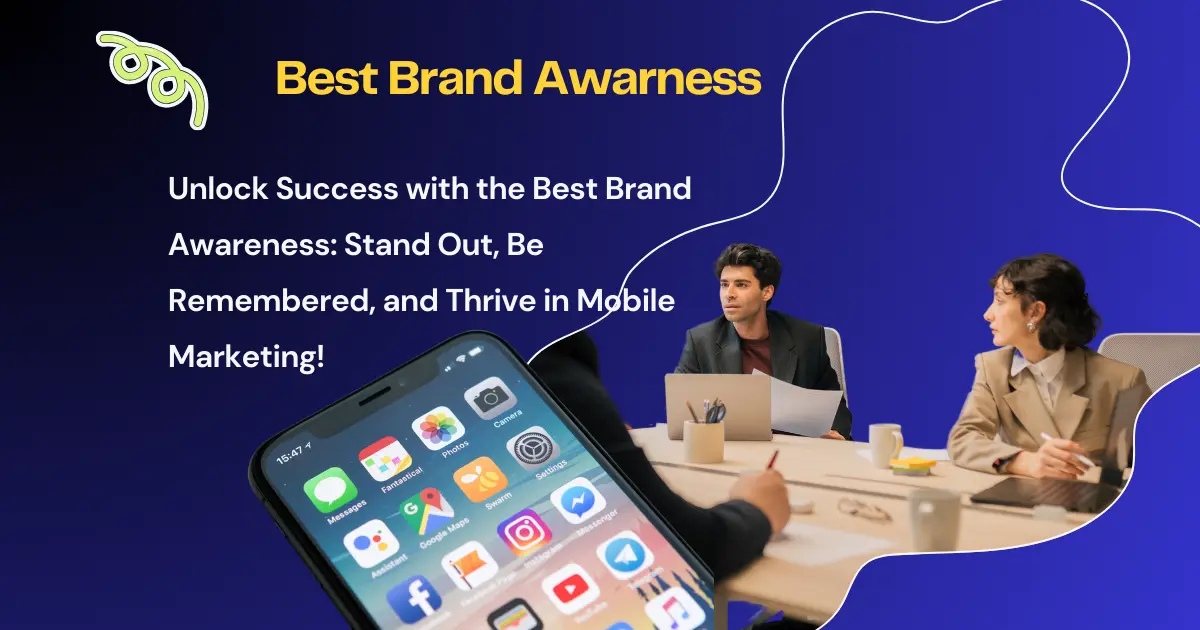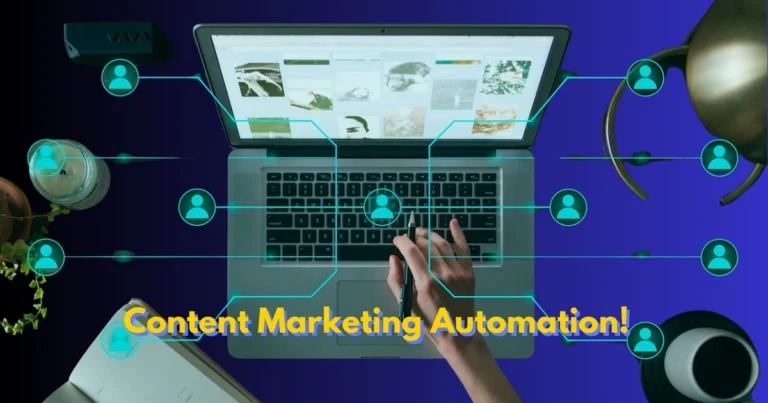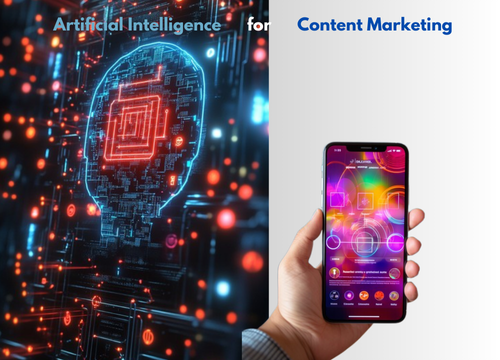The Road to Success: Achieving the Best Brand Awareness in Mobile Marketing

Achieving the best brand awareness is essential for businesses striving to stand out in competitive markets. Brand awareness ensures that consumers recognize and recall a brand, which is pivotal for building trust, driving loyalty, and encouraging purchase decisions. Mobile marketing offers unparalleled opportunities to connect with audiences on platforms they interact with daily, from social media apps to personalized push notifications.
The journey to building the best brand awareness requires a strategic combination of innovative technologies, engaging content, and data-driven insights. This article explores key strategies, stages, and tools for creating exceptional brand awareness, with a dedicated focus on mobile marketing. By leveraging these techniques, businesses can build long-lasting relationships with their audience and secure a leading position in their industries.
Table of Contents
1. The Importance of Best Brand Awareness in Mobile Marketing
Brand awareness plays a crucial role in shaping consumer perceptions and ensuring long-term success. Mobile marketing, with its ability to provide personalized and real-time interactions, is the ultimate channel for creating the best brand awareness.
1.1 Why Best Brand Awareness in Mobile Marketing Matters
Achieving the best brand awareness offers several advantages:
- Builds Trust: Consumers trust brands they recognize, making trust a key driver of sales and loyalty.
- Drives Loyalty: A consistent brand presence leads to loyal customers who advocate for your products or services.
- Enhances Competitiveness: Strong brand awareness helps businesses stand out in saturated markets.
For instance, brands like Amazon and Starbucks have become synonymous with convenience and personalization through their mobile strategies. These companies leverage mobile apps, geo-targeting, and push notifications to remain visible and relevant.
Table 1. Comparison Table: Key Mobile Marketing Channels for Brand Awareness
| Channel | Strengths | Example |
|---|---|---|
| Social Media | Wide reach, high engagement, mobile-optimized ads | Instagram, TikTok |
| Mobile Apps | Personalized user experience, push notifications | Starbucks, Nike Run Club |
| SMS Marketing | Direct communication, high open rates | E-commerce promotions |
| Mobile Advertising | Location-based targeting, interactive ad formats | Candy Crush playable ads |
| Influencer Marketing | Authentic connections, audience trust | Fashion Nova influencers |
1.2 Consequences of No Brand Awareness and Marketing Strategy
Without a clear strategy to achieve the best brand awareness, businesses risk being overlooked. Analytical insights reveal several challenges:
- Low engagement metrics, such as weak social media impressions or app downloads.
- Difficulty retaining customers, resulting in high churn rates.
- Reliance on heavy discounts or price cuts to compete.
Failing to prioritize brand awareness not only limits growth but also erodes trust and credibility, making it harder to attract and retain customers in the long term.
1.3 Mobile Marketing Examples in Action
- Nike Run Club App: Combines gamification and personalized fitness challenges to reinforce brand recognition.
- Starbucks App: Uses push notifications and loyalty programs to stay top of mind, encouraging repeat business.
2. The 4 Stages of Brand Awareness
Understanding the consumer journey from unawareness to recall is key to achieving the best brand awareness. Each stage requires tailored strategies that align with consumer behaviors and preferences.

2.1 Unawareness
At this stage, potential customers are unaware of your brand’s existence.
- Mobile Strategy: Targeted mobile ads on platforms like Facebook, Instagram, and TikTok introduce your brand to specific audiences.
- Example: A new fitness app using Instagram Stories ads to showcase its benefits and drive app installs.
2.2 Recognition
Consumers start recognizing your brand name or logo but may not know much about your offerings.
- Mobile Strategy: Optimize app store listings with consistent branding elements like a recognizable logo, taglines, and clear descriptions.
- Example: Spotify’s consistent branding in app stores ensures users identify its app among competitors.
2.3 Consideration
Consumers begin associating your brand with their needs or desires.
- Mobile Strategy: Create educational content like how-to videos or interactive in-app tutorials.
- Example: Duolingo’s gamified lessons make language learning fun and position it as a go-to educational app.
2.4 Recall
Your brand becomes the first choice when consumers think of a specific product or service.
- Mobile Strategy: Leverage personalized push notifications to re-engage users and encourage repeat interactions.
- Example: Amazon’s “Deal of the Day” notifications keep users coming back to their app.
Table 2. Stages Table: The 4 Stages of Brand Awareness in Mobile Marketing
| Stage | Description | Mobile Strategy Example |
|---|---|---|
| Unawareness | Consumers are unaware of the brand | Launch mobile ads targeting specific demographics |
| Recognition | Consumers recognize the brand name or logo | Optimize app store listings with logos and taglines |
| Consideration | Consumers associate the brand with their needs | Deliver targeted in-app tutorials or explainer videos |
| Recall | Consumers actively recall the brand for specific needs | Use loyalty programs and personalized push notifications |
3. The 3 Types of Brand Awareness

To achieve the best brand awareness, businesses must excel in all three types:
3.1 Brand Recall
Consumers think of your brand without external prompts.
- Example: Google dominates search engine recall, as most people refer to online searches as “Googling.”
3.2 Brand Recognition
Consumers recognize visual or auditory cues associated with your brand.
- Example: McDonald’s golden arches are an iconic visual cue that drives instant recognition.
3.3 Top-of-Mind Awareness
Your brand is the first mentioned in its category.
- Example: Uber’s dominance in ride-hailing apps ensures it’s the top-of-mind choice for most consumers.
Focusing on these types allows brands to remain competitive and secure a strong presence in the mobile landscape.
4. Best Brand Awareness Strategies for Mobile Marketing
Achieving the best brand awareness requires a mix of innovative tools, creative content, and data-driven tactics.
4.1 Social Media Marketing
Social media platforms are essential for building mobile-first brand awareness.
- Mobile Best Practices:
- Use vertical video ads optimized for Instagram Reels and TikTok.
- Engage users with live Q&A sessions or influencer takeovers.
- Example: Oreo’s Instagram campaigns use playful content to resonate with mobile audiences.
4.2 Influencer Partnerships
Collaborating with influencers helps brands tap into existing trust and credibility.
- Mobile Best Practices:
- Partner with micro-influencers for niche audiences.
- Track campaign performance with affiliate links or promo codes.
- Example: Gymshark’s influencer collaborations drive massive engagement among fitness enthusiasts.
4.3 Content Marketing
Mobile-optimized content is critical for achieving the best brand awareness.
- Mobile Best Practices:
- Focus on short, engaging videos and infographics.
- Optimize blog posts for mobile search queries.
- Example: HubSpot’s mobile-friendly guides establish it as a trusted resource in marketing education.
- 87% of B2C marketers state that content marketing successfully enhances brand awareness.
- The mobile marketing market size is projected to increase five-fold by 2030.
Table 3. Content Type Table: Best Mobile Content for Brand Awareness
| Content Type | Why It Works | Mobile Optimization Tips |
|---|---|---|
| Short-Form Videos | High engagement, easily consumable on mobile | Vertical formats, quick load times |
| Infographics | Visually appealing, conveys information quickly | Mobile-friendly layouts |
| Interactive Content | Boosts user interaction and engagement | Gamified quizzes or polls |
| Blogs | Provides value and drives traffic | Use AMP (Accelerated Mobile Pages) |
| Push Notifications | Directly reaches users, encourages action | Personalize content based on user behavior |
4.4 Gamification
Adding game-like features increases user engagement and enhances brand recall.
- Mobile Best Practices:
- Use in-app achievements and leaderboards to motivate users.
- Promote gamified features on social media to attract new users.
- Example: Nike Run Club’s gamified challenges keep users engaged while reinforcing brand loyalty.
4.5 Mobile Advertising
Mobile ads ensure your brand reaches users effectively.
- Mobile Best Practices:
- Leverage interactive formats like playable ads.
- Use retargeting to re-engage users who have interacted with your app or website.
- Example: Candy Crush’s playable ads demonstrate the game experience, driving millions of downloads.
- Over 60% of customers are willing to pay more for products from brands they are loyal to.
- 33% of brands use paid advertising to personalize experiences and boost brand awareness.
5. Measuring Success in Achieving the Best Brand Awareness
Tracking performance metrics is critical for refining strategies and achieving the best brand awareness.
5.1 Key Metrics
- App downloads and retention rates.
- Engagement rates for push notifications.
- Social media impressions and shares.
Table 4. Metrics Table: Measuring Brand Awareness in Mobile Marketing
| Metric | Description | Tools to Measure |
|---|---|---|
| App Downloads | Total number of app installations | App Store, Google Play Console |
| Push Notification Engagement | Click-through rates on push notifications | OneSignal, Firebase |
| Social Media Reach | Total impressions and reach from mobile platforms | Instagram Insights, TikTok Analytics |
| Mobile Ad Click-Through Rates | Percentage of users clicking on mobile ads | Google Ads, Facebook Ads Manager |
| Brand Recall Surveys | Surveys measuring consumer brand recognition | SurveyMonkey, Typeform |
5.2 Tools for Evaluation
- Google Analytics: Provides insights into mobile traffic and user behavior.
- App Annie: Tracks app performance, including downloads and rankings.
Table 5. Mobile Marketing Tools Comparison
| Tool | Purpose | Unique Features | Example Use |
|---|---|---|---|
| Google Ads | Mobile advertising | Location targeting, responsive ad formats | Mobile app install campaigns |
| Adjust | App performance tracking | Attribution analytics, fraud prevention | Measure app install sources |
| OneSignal | Push notification management | Segmentation, A/B testing | Sending targeted push notifications |
| TikTok Ads Manager | Social media ad campaigns | Vertical video ads, precise audience targeting | Run TikTok-specific campaigns |
| App Annie | App store analytics | Market insights, competitor tracking | Tracking app downloads and rankings |
5.3 Continuous Improvement
Use data insights to refine campaigns, test new content formats, and adapt to evolving audience preferences.
6. Best Practices for Achieving the Best Brand Awareness
To secure the best brand awareness, businesses should follow these principles:
- Consistency: Ensure your branding is uniform across mobile platforms, from app stores to social media.
- Personalization: Use mobile tools like geo-targeted ads and tailored push notifications to connect with individual users.
- Innovation: Leverage emerging technologies like augmented reality (AR) and artificial intelligence (AI) to create memorable brand experiences.
Table 6. Innovations Table: How Emerging Technologies Enhance Brand Awareness
| Technology | Functionality | Example |
|---|---|---|
| Artificial Intelligence | Personalized recommendations, automated insights | Spotify’s AI-curated playlists |
| Augmented Reality (AR) | Immersive experiences | IKEA’s AR app for product visualization |
| Gamification | Engages users with rewards and achievements | Nike Run Club’s leaderboard challenges |
Conclusion
Achieving the best brand awareness is both a goal and a necessity for businesses looking to thrive in today’s mobile-first economy. By leveraging mobile marketing strategies such as social media campaigns, influencer collaborations, and gamification, brands can create personalized, engaging experiences that resonate with audiences and drive loyalty.
The path to the best brand awareness requires understanding consumer behavior at every stage of the awareness journey, from unawareness to recall. By combining creative approaches with data-driven insights, businesses can ensure their brand remains visible, memorable, and competitive.
With mobile marketing as the backbone of modern brand awareness strategies, businesses have the tools to build long-lasting customer relationships and achieve sustainable growth in an ever-changing market.
FAQs: Best Brand Awareness in Mobile Marketing
1. What is brand awareness and why is it important?
Answer:
Brand awareness is the degree to which consumers recognize and recall your brand. It’s important because it builds trust, drives loyalty, and sets your business apart in competitive markets. In mobile marketing, strong brand awareness ensures your brand stays top-of-mind for users interacting through apps, social media, and mobile ads.
2. What are the stages of brand awareness?
Answer:
The four stages of brand awareness are:
- Unawareness: Consumers are unfamiliar with your brand.
- Recognition: Consumers start recognizing your logo, name, or tagline.
- Consideration: Consumers associate your brand with specific needs or desires.
- Recall: Consumers think of your brand first when considering a product or service in your category.
3. How can mobile marketing improve brand awareness?
Answer:
Mobile marketing enhances brand awareness by leveraging personalized experiences, location-based ads, and real-time engagement. Tactics such as push notifications, gamified apps, and mobile-optimized social media campaigns ensure your brand connects with users where they spend most of their time.
4. What are the best strategies for achieving the best brand awareness?
Answer:
Key strategies include:
- Social media marketing with mobile-friendly content.
- Influencer collaborations targeting mobile-first audiences.
- Gamification in apps to boost engagement.
- Personalized push notifications to drive recall.
- Data-driven mobile ads to reach specific demographics effectively.
5. What tools help measure brand awareness in mobile marketing?
Answer:
Tools like Google Analytics, App Annie, Brandwatch, and OneSignal track metrics such as app downloads, social media impressions, push notification engagement, and brand mentions. These insights help refine strategies to achieve the best results.
6. What are the consequences of not focusing on brand awareness?
Answer:
Without brand awareness, businesses face challenges like low visibility, poor customer engagement, and weak loyalty. This often leads to higher churn rates, reliance on discounts to attract customers, and ultimately, reduced market presence and growth.
7. How do gamification and AI improve brand awareness?
Answer:
Gamification engages users by incorporating rewards, achievements, and challenges in mobile apps, making the brand experience memorable. AI enhances personalization, delivering tailored content and recommendations that resonate with users, strengthening their connection to your brand.
8. What are the 3 types of brand awareness?
Answer:
The three types are:
- Brand Recall: Consumers remember your brand without prompts.
- Brand Recognition: Consumers identify your brand through visual or auditory cues.
- Top-of-Mind Awareness: Your brand is the first mentioned in its category.






